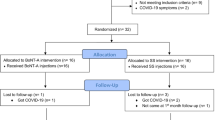Abstract
Objectives
The aim of this study was to evaluate the efficacy of conventional TENS in women affected by chronic facial myalgia.
Materials and methods
The study was performed on 49 women affected by chronic facial myalgia randomly allocated in the TENS group (34 women) and the control group (15 women). The subjective level of pain was assessed by the Visual Analogue Scale indicating the mean (VAS MEAN), the maximum (VAS MAX) and the current intensity of pain (VAS NOW). The level of pain at the muscular palpation sites was assessed by the Pericranial Muscle Tenderness Score (PTS) and the Cervical Muscle Tenderness Score (CTS).
The TENS therapy lasted for 10 weeks, and data were collected at baseline, after 5, 10, 15 and 25 weeks. The differences between groups before and after treatment were compared with the Mann-Whitney and the Kolmogorov-Smirnov tests. The intra-group differences were compared with the one-way ANOVA test.
Results
The results showed that the VAS MEAN, VAS MAX, PTS and CTS were significantly reduced in the TENS group compared to the control group after 10 weeks of TENS (p < 0.05). The intra-group analysis revealed a decreasing tendency of VAS MEAN, VAS MAX, VAS NOW, PTS and CTS in the TENS group in a 25-week period (p < 0.05).
Conclusions
The study demonstrated the efficacy of conventional TENS in patients with chronic facial myalgia and the decrease in both subjective and objective pain.
Clinical relevance
Conventional TENS is a safe, non-invasive, easy-to-administer therapy for chronic facial myalgia.



Similar content being viewed by others
References
McNeil C (1993) The American Academy of Orofacial Pain. In: Temporomandibular disorders. Guideline for Classification, Assessment an Management. Quintessence Publishing Co, Carol Stream, Illinois
National Institute of Dental and Craniofacial Research (2014) Facial pain. http://www.nidcr.nih.gov/DataStatistics/FindDataByTopic/FacialPain/ Accessed 26 June 2015
Zarb GA, Mock D (1999) On emphasizing a scientifically prudent approach to the management of temporomandibular disorders. J of Orofac Pain 13(4):221–222
Fricton JR, Dubner R (1995) Orofacial pain and temporomandibular disorders. Raven Press, New York, NY
Johnson MI (2014) Transcutaneous electrical nerve stimulation (TENS): research to support clinical practice. Oxford University Press, Oxford
McNeely ML, Olivo SA, Magee DJ (2006) A systematic review of the effectiveness of physical therapy interventions for temporomandibular disorders. Phys Ther 86:710–725
Feine JS, Lund JP (1997) An assessment of the efficacy of physical therapy and physical modalities for the control of chronic musculoskeletal pain. Pain 71:5–23
Carroll D, Moore RA, McQuay HJ, Fairman F, Tramèr M, Leijon G (2001) Transcutaneous electrical nerve stimulation (TENS) for chronic pain. Cochrane Database Syst Rev (3):CD003222:1–43
Nnoaham KE, Kumbang J (2008) Transcutaneous electrical nerve stimulation (TENS) for chronic pain. Cochrane Database Syst Rev (3):CD003222:1–54
Johnson M, Martinson M (2007) Efficacy of electrical nerve stimulation for chronic musculoskeletal pain: a meta-analysis of randomized controlled trials. Pain 130:157–165
Gui MS, Rizzatti-Barbosa CM (2015) Chronicity factors of temporomandibular disorders: a critical review of the literature. Braz Oral Res 29(1):1–6
King EW, Audette K, Athman GA, Nguyen HO, Sluka KA, Fairbanks CA (2005) Transcutaneous electrical nerve stimulation activates peripherally located alpha-2A adrenergic receptors. Pain 115(3):364–373
Charlton J (2005) Task Force on Professional Education. Stimulation-produced analgesia. In: Charlton J (ed) Task Force on Professional education. IASP Press, Seattle, WA, pp. 93–96
Schiffman E, Ohrbach R, Truelove E et al. (2014) Diagnostic Criteria for Temporomandibular Disorders (DC/TMD) for Clinical and Research Applications: recommendations of the International RDC/TMD Consortium Network and Orofacial Pain Special Interest Group. J Oral Facial Pain Headache 28(1):6–27
Seymour RA, Simpson JM, Charlton JE, Philips ME (1985) An evaluation of length and end phrase of visual analogue scale in dental pain. Pain 21:177–185
Mongini F, Ciccone G, Deregibus A, Ferrero L, Mongini T (2004) Muscle tenderness in different headache types and its relation to anxiety and depression. Pain 112(1–2):59–64
Hermens HJ, Freriks B, Disselhorst-Klug C, Rau G (2000) Development of recommendations for SEMG sensors and sensor placement procedures. J Electromyogr Kinesiol 10(5):361–74
Castroflorio T, Farina D, Bottin A, Debernardi C, Bracco P (2005) Non-invasive assessment of motor unit anatomy in jaw-elevator muscles. J Oral Rehabil 32(10):708–713
Claydon LS, Chesterton LS, Barlas P, Sim J (2011) Dose-specific effects of transcutaneous electrical nerve stimulation (TENS) on experimental pain: a systematic review. Clin J Pain 27(7):635–647
Cheing G, Tsui A, Lo S, Hui C (2003) Optimal stimulation duration of TENS in the management of osteoarthritic knee pain. J Rehabil Med 35:62–68
Johnson MI, Ashton CH, Thompson JW (1991) An in-depth study of long-term users of transcutaneous electrical nerve stimulation (TENS). Implications for clinical use of TENS. Pain 44:221–229
Garrison DW, Foreman RD (2002) Effects of transcutaneous electrical nerve stimulation (TENS) electrode placement on spontaneous and noxiously evoked dorsal horn cell activity in the cat. Neuromodulation 5(4):231–237
De Freitas RFCP, Ferreira MAF, Barbosa GAS, Calderon PS (2013) Counselling and self-management therapies for temporomandibular disorders: a systematic review. J Oral Rehabil 40:864–874
Reid KI, Greene CS (2013) Diagnosis and treatment of temporomandibular disorders: an ethical analysis of current practices. J Oral Rehabil 40:546–561
Romero-Reyes M, Uyanik JM (2014) Orofacial Pain management: current perspectives. J Pain Res 7:99–115
Author information
Authors and Affiliations
Corresponding author
Ethics declarations
All procedures performed in the study were in accordance with the ethical standards of the Local Ethical Committee (#3742015) and with the Helsinki Declaration.
Conflict of interest
The authors declare that there are no relevant conflicts of interest in the preparation of the manuscript.
Funding
The study was funded by CIR Dental School, University of Torino, Italy.
Informed consent
Informed consent was obtained from all individual participants included in the study.
Rights and permissions
About this article
Cite this article
De Giorgi, I., Castroflorio, T., Sartoris, B. et al. The use of conventional transcutaneous electrical nerve stimulation in chronic facial myalgia patients. Clin Oral Invest 21, 275–280 (2017). https://doi.org/10.1007/s00784-016-1787-2
Received:
Accepted:
Published:
Issue Date:
DOI: https://doi.org/10.1007/s00784-016-1787-2




